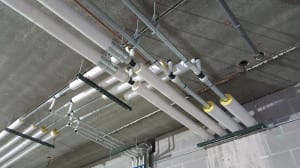While the commercial industry is seeing a growing interest in the use of PEX for hydronic heating and chilled water applications, some professionals are still skeptical that a plastic piping system can actually perform as well as traditional copper and steel.
Let’s turn some of that skepticism into knowledge by answering some of the most common questions about PEX for hydronic piping and detail the facts that will confirm PEX can provide superior performance and reliability while also reducing installation times, project schedules and costs.
What is PEX?
PEX is an acronym for crosslinked polyethylene. It is a flexible, durable, plastic piping material that has been used in radiant heating applications for more than four decades and plumbing applications for the past two decades. PEX has three different manufacturing types to create piping that is crosslinked to varying degrees. PEX-a uses the Engel method which creates piping crosslinked to 80% or more; PEX-b uses the Silane method for piping that is 65 to 70% crosslinked; and PEX-c uses the radiation method to create 70 to 75% crosslinked pipe. The higher the crosslinking, the more flexible and durable the piping.
 What are the temperature and pressure ratings for PEX?
What are the temperature and pressure ratings for PEX?
Most PEX is rated for the following temperatures and pressures:
- 200°F at 80 psi
- 180°F at 100 psi
- 73.4°F at 160 psi
At 200°F at 80 psi, any hydronic application with water temperatures at or below this value is perfectly applicable for the product.
How do you manage the expansion and contraction of PEX?
PEX expands at a rate of 1.1″ per 100 ft. of pipe for every 10 degrees of temperature change. Using a PEX pipe support steel channel will control this natural expansion and contraction that occurs as the piping heats and cools. In fact, using PEX pipe support in conjunction with strut and strut clamps can reduce the expansion rate to 0.08″/100 ft./10°F, which is actually less than that of copper at 0.11″/100 ft./10°F. And using PEX pipe support with clevis or loop hangers offers an expansion rate of 0.12″/100 ft./10°F, just slightly more than copper.
Does PEX require more hangers and supports than metallic systems?
Using the PEX pipe support steel channel allows PEX to have similar hanger spacing to metallic systems, offering ½” and ¾” PEX pipe at 6-ft. spacing and 1″ to 3″ PEX pipe at 8-ft. spacing.
How is installing PEX better than copper or steel for hydronic piping applications?
Let me count the ways…
- PEX is not an open-market commodity like copper, so its pricing is far more stable over time, making it easier and more reliable to bid jobs.
- PEX can be run in continuous coils up to 1,000 feet in length which results in fewer required fittings.
- Because PEX does not pit, scale or corrode, it requires fewer nitrites, azoles and other chemicals inside the piping system to maintain a static hydronic environment.
- Making PEX connections involves no hot work, eliminating the need for open flame as well as the expense for fire-watch measures on a jobsite.
- PEX connections also eliminate the need for glues, solvents and other dangerous chemicals on the jobsite.
- PEX is significantly lighter than metallic piping (e.g., a stick of copper is three times heavier than a stick of PEX) so PEX is much easier and safer to move around the jobsite.
To learn more about PEX system solutions, visit uponorpro.com.
 Kim Bliss is the technical communications manager at Uponor. She holds more than 25 years of writing experience with an emphasis in technical and manufacturing. She can be reached at kim.bliss@uponor.com.
Kim Bliss is the technical communications manager at Uponor. She holds more than 25 years of writing experience with an emphasis in technical and manufacturing. She can be reached at kim.bliss@uponor.com.




Join the conversation: